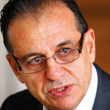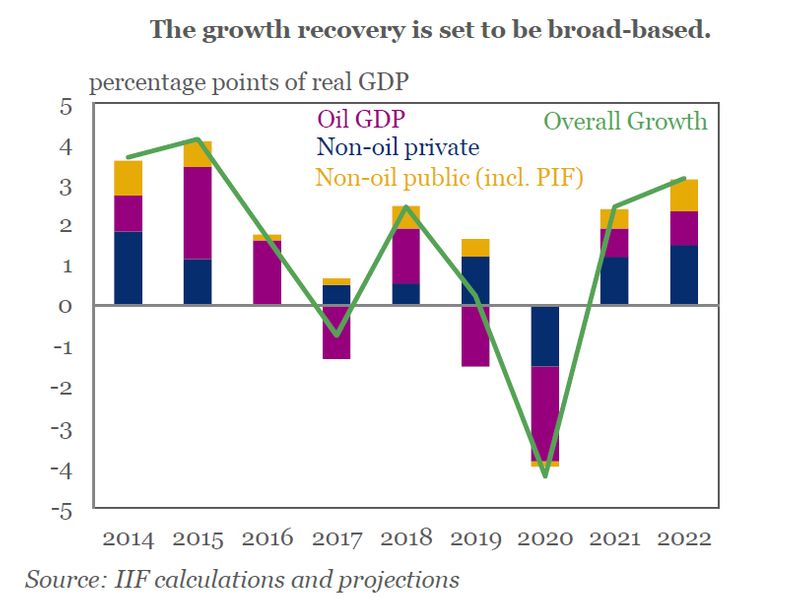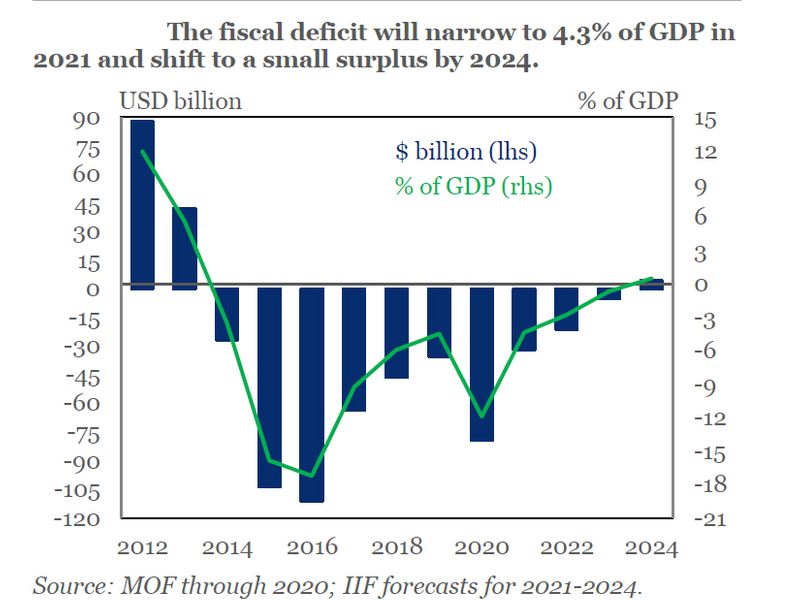
Dubai: Saudi Arabia’s economy is set for a turnaround in 2021 supported by recovery in oil and non-oil sectors combined with effective containment of COVID-19, according to the Institute of International Finance (IIF).
Latest forecasts from the IIF, a Washington based association of global financial institutions show the Saudi GDP is expected to grow 2.4 per cent in 2021 compared to a 4.2 per cent contraction in 2020.
“We expect modest economic recovery in 2021, with nonoil real GDP growing by 3 per cent in 2021, following a contraction of 2.7 per cent in 2020. The recovery will be supported by the large Public Investment Fund (PIF) projects underway,” said Garbis Iradian, Chief Economist, Mena of the IIF.
Infection control
The rapid implementation of COVID containment measures has helped limit the health impact of the pandemic. The number of deaths in the kingdom has been relatively low, supported also by the relatively young population (only 3 per cent of the population is over 65), improved testing, and better treatment of the virus in hospitals.

Monetary policy will remain accommodative until the recovery is well-established. The banking system has remained relatively resilient, helped by sound initial capital and liquidity positions and flexible response by the central bank including regulatory forbearance.
The GDP contraction in 2020 was less severe than in advanced and emerging economies. Preliminary official data show that the Saudi economy contracted by 4.1 per cent in 2020, driven by a sharp contraction in oil GDP in the context of OPEC+ oil production cuts.
The non-oil real GDP shrank only by 2.7 per cent, a less severe drop than in many other G20 countries due to the kingdom’s relatively small services sector and young population. Nonetheless, the recession has triggered significant job losses, with the national unemployment rate rising to 14.9 per cent in the third quarter 2020, partly due to the higher national labour force participation rate (49 per cent).
“We expect overall real GDP growth of 2.4 per cent in 2021 and 3.1 per cent in 2022 driven by non-oil growth of 3 per cent and 3.9 per cent, respectively,” said Iradian.

Recent economic data, including credit to the private sector and the PMI [purchasing managers’ index], suggest that output growth has been accelerating in recent months. The 3-month moving average PMI has increased from 45 in May 2020 to 56 in January 2021 (back to pre-pandemic levels).
The ongoing recovery is expected to accelerate in the second half of this year as the second wave of the pandemic recedes, COVID-19 vaccines become widely available, and oil production cuts are tapered in line with the OPEC+ agreement.
Strong policy support
The authorities have implemented a range of measures to mitigate the economic damage, including fiscal packages, easing monetary and macroprudential rules, and providing adequate liquidity to the banking system.
“Monetary policy will remain accommodative until the recovery is well-established. The banking system has remained relatively resilient, helped by sound initial capital and liquidity positions and flexible response by the central bank including regulatory forbearance,” said Iradian.
SAMA (Saudi central banks) tracks the monetary policy of the US in the context of the peg to the US dollar.
SAMA lowered its reverse repo and repo rates by 1.25 percentage points to 0.5 and 1 per cent, respectively. SAMA has also introduced liquidity support measures amounting to 2 per cent of GDP to support the private sector, particularly SMEs, by allowing them to defer payments on existing loans and increase lending to businesses. Last November, SAMA announced the extension of payment deferral programme until the end of March 2021.
Plugging fiscal gap
The sharp fall in oil revenue widened the fiscal deficit to 11.9 per cent of GDP in 2020 from 4.5 per cent in 2019. The overspend in 2020 was largely due to goods and services, reflecting higher-than-expected outlays on the health sector. Financing was provided from drawdown on government reserves and new borrowing both domestically and externally.
Large scale project spending by the PIF is expected to offset the potential fiscal retrenchment to reduce the budget deficits.

The kingdom is expected to resume fiscal consolidation driven largely by cuts in capital expenditure, which may be more than offset by increasing role of the PIF in financing several mega projects. Higher oil prices combined with recovery in nonoil revenues will narrow the fiscal deficit from 11.9 per cent of GDP in 2020 to 4.3 per cent in 2021.
Large transfer of funds from SAMA (central bank) to the PIF will be a key source of funding for PIF projects and foreign investments. The IIF believes the current SAMA’s foreign reserves are estimated at $453 billion, well above the level needed to preserve the peg.
While transfers to PIF could result in a decline in SAMA’s FX reserves to $417 billion in 2021, the PIF domestic and foreign assets is forecast to rise to $422 billion in 2021 and $580 billion by 2024, based on historical investment returns, Aramco’s disbursements for the SABIC purchase, and privatization of few government entities.
Banks remain adequately capitalized with a high Tier 1 capital and low NPL. Bank profitability, while moderating, remains relatively high. Credit to the private sector increased by 14 per cent in December 2020, year on year. Maintaining the current healthy banking system and encouraging innovation in fintech and digital banking will support the economic recovery and promote financial inclusion.
Once the forbearance is lifted, we could see a modest deterioration in asset quality or an NPL ratio of more than 3 per cent. While Saudi banks’ provisions already cover more than 100 per cent of total NPLs, the current measures to encourage banks to postpone loan repayment installments through end-March 2021 conceal the true extent of bank asset quality deterioration.
Profitability challenges in the low-interest rate environment may also limit banks’ ability or willingness to expand private sector credit at the same pace as in 2020.
Surge in public debt
The large deficit combined with lower GDP led to a sharp increase in government debt, which rose from 23 per cent of GDP in 2019 to 34 percent in 2020.
The 2021 budget envisages total government spending cut of 7 per cent, with the capital side likely to shoulder the brunt of the cuts. The authorities expect the PIF to pick up the slack with additional spending on mega projects. Public sector wages and salaries, which account for 47 per cent of total spending or 20 per cent of GDP, are likely to remain the same in nominal terms.
The authorities expect to raise investment spending by the PIF into the economy to $40 billion each year in 2021 and 2022. The PIF is not part of the government accounts. With the recent pick up in oil prices, the fiscal deficit is expected to narrow from 11.9 per cent of GDP in 2020 to 4.3 percent of GDP in 2021.
“We project oil revenues to increase by 18 per cent. The tripling of the VAT to 15 per cent in July of 2020 combined with recovery in domestic demand could also raise non-oil revenues by 10 per cent in 2021,” said Iradian.
Assuming oil prices remain $50/bbl. in 2022 and thereafter, the fiscal deficit will narrow to 2.8 per cent of GDP in 2022 and shift to a small surplus by 2024.
The PIF is regarded as the main vehicle to diversify the economy away from oil and modernize the kingdom. It will increase its investments at home to $40 billion in 2021 (5.5 per cent of GDP), compared with $16 billion in 2019. Most of the investments will be concentrated in real-estate projects.
The PIF is currently involved in the development of NEOM, a $500 billion futuristic city in the north-western part of Saudi Arabia, a sports and entertainment complex, and a high-end Red Sea tourism project. Financing of such projects would come through a combination of bonds, loans, and equity from the estimated $360 billion PIF assets and from foreign investors.
Increasing potential growth requires deeper structural reforms that extend beyond the national megaprojects. The ambitious reform agenda underpins Saudi Arabia’s diversification efforts away from oil to raise potential growth.
While some progress has been made in implementing the needed reforms, bureaucracy, lack of transparency, and inefficiency remain major impediments to achieving sustained rapid private sector growth.
The kingdom needs to attract adequate FDI outside the energy sector to implement its plan to diversify and to create a dynamic and expanded private sector. Building a new, more diverse growth model will also hinge on improving the operating environment for the private sector, which would facilitate shifting national workers away from the public sector and promote effective partnership between the public and private sector.
With the number of national entrants into the labour force expected to grow rapidly given the demographic structure and the expected further increase in the female participation rate, it will be important to ensure that local education and training improve substantially.








